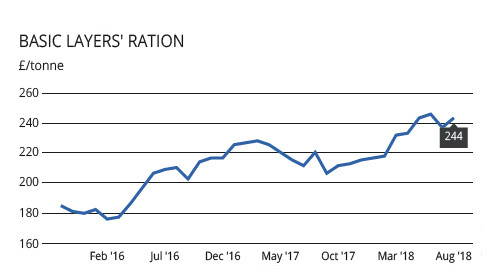Falling soya keeps feed prices flat

Although the cost of wheat is still rising, falling soya prices have kept a brake on feed costs for the second month running.
The UK average feed wheat spot price reached £171.70/t at the start of September, a new 5-year record, and a gain of nearly £6/t during the month.
When UK wheat spot prices were last at these highs, in the 2012-13 marketing year, prices topped out at £217 in that December.
Futures prices have already been pushing towards this level during August, as Humphrey Feeds noted: “November wheat futures remain volatile, trading at about £181.50/t. Between 29 June and now we have seen prices move up from £160/t to the month’s peak of £195.50/t, the highest value since April 2013.”
Current opinion was split among buyers, it said: “Some believe that we have seen the top of this rally, whilst others believe that insufficient rationing has yet taken place and there will be more (higher) priced rationing to come.”
Meanwhile soya has been heading down again, falling by £22/t during August to £321/t, and taking it back to February’s level.
The net result of these movements is to leave our price for a basic layers ration (top right) marginally down on a month ago, although still at 5-year highs.
| GRAIN MARKET DRIVERS | ||
WHEAT – a significant driver of global wheat prices at the start of September was the speculation that Russia would put a brake on exports this season. | ||
| WHEAT – Australia is expected to experience dry conditions all through spring. The latest IGC forecast lowered Australian wheat output by 3% compared with last year. | ||
| WHEAT – EU common wheat production is predicted to decline by 13.2 million tonnes in 2018-19 compared with last year, to 129 mt. | ||
| SOYA – The August USDA report put global soya production for the coming year at a record 367mt, against 337mt last year. Estimates for the 2018 US crop continue to grow, with risk management firm INT-FC Stone entering a forecast of 130mt. | ||
| SOYA – The arrival of rain in some US growing areas has dispelled concern for now about any adverse impact on the soya crop, with 66% rated as good to excellent in late August. | ||













